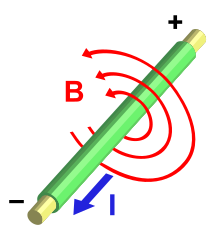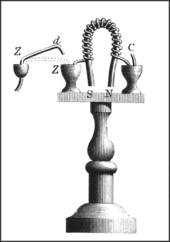An
electromagnet is a type of magnet in which the magnetic field is produced by the flow of electric current.
The magnetic field disappears when the current is turned off.
Electromagnets are widely used as components of other electrical
devices, such as motors, generators, relays, loudspeakers, hard disks, MRI machines, scientific instruments, and magnetic separation
equipment, as well as being employed as industrial lifting
electromagnets for picking up and moving heavy iron objects like scrap
iron.
 |
A simple electromagnet consisting of a coil of insulated wire
wrapped
around an iron core. The strength of magnetic field
generated is
proportional to the amount of current. |
 |
Current (I) through a wire produces a magnetic field (B).
The field is oriented according to the right-hand rule. |
An electric current flowing in a wire creates a magnetic field around
the wire (see drawing below). To concentrate the magnetic field, in an
electromagnet the wire is wound into a coil
with many turns of wire lying side by side. The magnetic field of all
the turns of wire passes through the center of the coil, creating a
strong magnetic field there. A coil forming the shape of a straight tube
(a helix) is called a solenoid. Much stronger magnetic fields can be produced if a "core" of ferromagnetic material, such as soft iron,
is placed inside the coil. The ferromagnetic core increases the
magnetic field to thousands of times the strength of the field of the
coil alone, due to the high magnetic permeability μ of the ferromagnetic material. This is called a ferromagnetic-core or iron-core electromagnet.
 |
Magnetic field produced by a solenoid
(coil of wire).
This drawing shows a cross section through the center
of the coil.
The crosses are wires in which current is moving into the
page;
the dots are wires in which current is moving up out of the page. |
The direction of the magnetic field through a coil of wire can be found from a form of the right-hand rule.
If the fingers of the right hand are curled around the coil in the direction of current flow (conventional current, flow of positive charge)
through the windings, the thumb points in the direction of the field
inside the coil. The side of the magnet that the field lines emerge from
is defined to be the
north pole.
The main advantage of an electromagnet over a permanent magnet
is that the magnetic field can be rapidly manipulated over a wide range
by controlling the amount of electric current. However, a continuous
supply of electrical energy is required to maintain the field.
How the iron core works
The material of the core of the magnet (usually iron) is composed of small regions called magnetic domains that act like tiny magnets.
Before the current in the electromagnet is turned on, the domains in
the iron core point in random directions, so their tiny magnetic fields
cancel each other out, and the iron has no large scale magnetic field.
When a current is passed through the wire wrapped around the iron, its
magnetic field penetrates the iron, and causes the domains to turn,
aligning parallel to the magnetic field, so their tiny magnetic fields
add to the wire's field, creating a large magnetic field that extends
into the space around the magnet. The larger the current passed through
the wire coil, the more the domains align, and the stronger the magnetic
field is. Finally all the domains are lined up, and further increases
in current only cause slight increases in the magnetic field: this
phenomenon is called saturation.
When the current in the coil is turned off, most of the domains lose
alignment and return to a random state and the field disappears. However
some of the alignment persists, because the domains have difficulty
turning their direction of magnetization, leaving the core a weak
permanent magnet. This phenomenon is called hysteresis and the remaining magnetic field is called remanent magnetism. The residual magnetization of the core can be removed by degaussing.
 |
| Electromagnet used in the Tevatron particle accelerator, Fermilab, USA |
 |
| Laboratory electromagnet used in physics experiments, around 1910 |
 |
| Magnet in a mass spectrometer |
 |
| AC electromagnet on the stator of an electric motor |
 |
| Magnets in an electric bell |
History
 |
| Sturgeon's electromagnet, 1824 |
Danish scientist Hans Christian Ørsted discovered in 1820 that electric currents create magnetic fields. British scientist William Sturgeon invented the electromagnet in 1824. His first electromagnet was a horseshoe-shaped piece of iron that was wrapped with about 18 turns of bare copper wire (insulated wire didn't exist yet). The iron was varnished
to insulate it from the windings. When a current was passed through the
coil, the iron became magnetized and attracted other pieces of iron;
when the current was stopped, it lost magnetization. Sturgeon displayed
its power by showing that although it only weighed seven ounces (roughly
200 grams), it could lift nine pounds (roughly 4 kilos) when the
current of a single-cell battery was applied. However, Sturgeon's
magnets were weak because the uninsulated wire he used could only be
wrapped in a single spaced out layer around the core, limiting the
number of turns. Beginning in 1827, US scientist Joseph Henry systematically improved and popularized the electromagnet.
By using wire insulated by silk thread he was able to wind multiple
layers of wire on cores, creating powerful magnets with thousands of
turns of wire, including one that could support 2,063 lb (936 kg). The
first major use for electromagnets was in telegraph sounders.
The magnetic domain theory of how ferromagnetic cores work was first proposed in 1906 by French physicist Pierre-Ernest Weiss, and the detailed modern quantum mechanical theory of ferromagnetism was worked out in the 1920s by Werner Heisenberg, Lev Landau, Felix Bloch and others.









0 komentar:
Posting Komentar